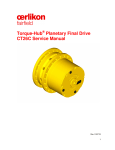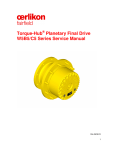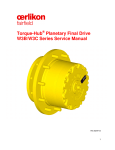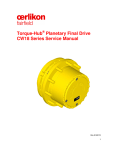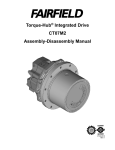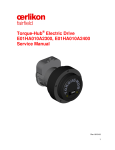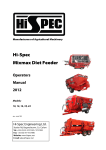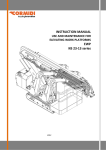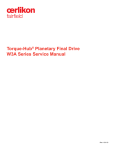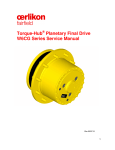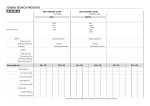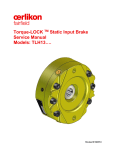Download Torque-Hub Planetary Final Drive W9T Series Service Manual
Transcript
Torque-Hub® Planetary Final Drive W9T Series Service Manual Rev 03/12/13 1 While every precaution has been taken in the preparation of this document, Fairfield Manufacturing Co. Inc. assumes no liability with respect to the use of the documentation described herein, or for any act or omission of Fairfield Manufacturing Co. Inc. concerning this documentation. Torque-Hub® is a registered trademark of Fairfield Manufacturing Co. Inc. Features and specifications are subject to change without notice. 2 Planetary Final Drive Service Manual Content Disassembly Instructions Assembly Instructions General Information Introduction Brake Test Roll and Leak Test Tightening and Torquing Bolts Lubrication Information Main Disassembly Output Carrier Disassembly Input Carrier Disassembly Housing-Spindle Disassembly Input Brake Disassembly Carrier Disassembly Input Carrier Subassembly Output Carrier Subassembly Input Brake Subassembly Carrier Subassembly Housing-Spindle Subassembly Main Assembly Assembly Drawing Parts List Assembly Tools Contact Information 4 5 10 12 13 16 18 19 20 22 25 27 29 30 34 36 38 39 40 42 55 3 Planetary Final Drive Service Manual Introduction This manual is a step-by-step guide to the disassembly and ® assembly of the W9T Torque-Hub units. It is designed for the ® customer or mechanic who is repairing this particular Torque-Hub model. Users of this manual should note that each part mentioned is followed by an identification number enclosed in parentheses. These part numbers may be referred to in the Parts List and Assembly Drawing sections of this manual. Specialized tools used to assemble this unit are noted in the assembly procedures and diagrammed in the Assembly Tools section. Users should familiarize themselves with the procedures for roll and leak testing, as well as bolt tightening and torquing found on the following three pages before starting any repairs. Standard safety practices should be followed during the disassembly and assembly procedures described. Safety glasses and safety shoes should be worn, and heavy, heat resistant gloves should be used when handling heated components. Be especially alert when you see the word CAUTION. This indicates that a particular operation could cause personal injury if not performed properly or if certain safety procedures are not followed. The word NOTE is used to bring attention to certain procedures or helpful hints that will aid in the disassembly and assembly process. 4 Planetary Final Drive Service Manual Brake Test The Brake Test To perform a brake check, use a .437-20 UNC fitting. Install a hydraulic hand pump with pressure gauge into low speed brake port in spindle (1A) using thread fitting. Place ROLL TEST Tool (refer to table on page 10) into input coupling. Apply 25 in-lbs torque. While trying to rotate tool, pump the handle on the hydraulic hand pump and increase the pressure until the brake releases. The brake is released when you are able to rotate the tool. Record the release pressure. If the brake does not release within limits shown in the low speed brake chart on page 6, check to see if it has the proper number of springs using the SPRING CHECKING PROCEDURE. Increase to maximum pressure (refer to low speed brake chart on page 6) and hold at that pressure for one minute. If the brake does not leak or lose pressure, the unit has passed the brake test. If the brake loses pressure, attempt to repair the leak using the leak repair procedure at end of this procedure. While brake is still released, roll check the unit for one revolution of the output member by rotating the tool. Bleed off pressure slowly while rotating the ROLL TEST Tool. Continued on Next Page 5 Record the pressure at which the brake locks up. Using a clean rag, wipe off excess fluid from around the brake port and install the pipe plug. Repeat steps above for high speed brake port using high speed brake chart as reference. BRAKE REFERENCE CHART – LOW SPEED BRAKE PART NUMBER NUMB ER OF SPRIN GS RELEASE PRESSURE MIN (psi) RELEASE PRESSURE MAX (psi) FULL RELEASE PRESSUR E (psi) MAXIMUM PRESSURE (psi) BRAKE TORQU E(in-lbs) W9Txxxxxxxx 18 240 300 370 1500 4000 W9T34D435 14 187 235 290 1500 3000 Continued on Next Page 6 BRAKE REFERENCE CHART – HIGH SPEED BRAKE PART NUMBER NUMBER OF SPRINGS RELEASE PRESSURE MIN (psi) FULL RELEASE PRESSURE (psi) MAXIMUM PRESSURE (psi) BRAKE TORQUE (in-lbs) 295 RELEAS E PRESSU RE MAX (psi) 335 W9Txxxxxxxx 30 400 1500 4000 W9T30D435 21 207 235 300 1500 3000 SPRING CHECKING PROCEDURE: Remove twelve bolts out of the Input Cover in such a way to ensure the Input Cover remains straight while releasing compressed pressure out of brake cavity of the spindle. Carefully remove the Input Cover from the end of the input brake and count the number of springs in brake. If number of springs matches the number in the LOW SPEED BRAKE CHART, go to the next step. If the number of springs does not match the number in the LOW SPEED BRAKE CHART above, install the correct number of springs. Continued on Next Page 7 Carefully remove Brake Piston (130) and Piston Spacer (108) from the Spindle (100). Count the number of springs in brake piston (136). If number of springs matches the number in the HIGH SPEED BRAKE CHART, go to the next step. If the number of springs does not match the number in the HIGH SPEED BRAKE CHART above, install the correct number of springs. Install Brake Piston (130) and Piston Spacer (108) into Spindle. Install the Input Cover using twelve bolts. Install twelve bolts into holes in Input Cover as equally spaced as possible. Tighten bolts in such a way that to ensure the Input Cover remains straight while being compressed into the brake cavity of the spindle. NOTE: CARE SHOULD BE TAKEN WHILE INSTALLING OR UNINSTALLING THE BOLTS ON INPUT COVER AS THEY ARE SUBJECTED TO SPRING PRESSURE. Re-test the input brake. If release and/or lockup pressures still do not match the brake chart, contact the Oerlikon Fairfield service department. Continued on Next Page 8 BRAKE LEAK REPAIR PROCEDURE: Remove twelve bolts out of the Input Cover in such a way to ensure the Input Cover remains straight while releasing compressed pressure out of brake cavity of the spindle. Carefully remove the Input Cover from the end of the input brake, remove the Brake Piston’s from the Spindle. Check O-rings, Backup Rings, and brake cavity in Spindle for damage. If no damage is found, reinstall the Input Brake according to the Input Brake Installation Procedure in the assembly instructions chapter and perform pressure test again. If brake still leaks, contact the Oerlikon Fairfield service department. NOTE: Failure to perform this test may result in damaged or ineffective brake parts. 9 Planetary Final Drive Service Manual Roll and Leak Test ® Torque-Hub units should always be roll and leak tested before disassembly (if possible) and after assembly to make sure the unit’s gears, bearings and seals are working properly. The following information briefly outlines what to look for when performing these tests. The Roll Test The purpose of the roll test is to determine if the unit’s gears are rotating consistently, easily and properly. It should be able to rotate the gears in the unit applying constant force to the roll checker. If more drag is felt in the gears only at certain points, then the gears are not rolling consistently and easily and should be examined for improper installation or defects. Some gear packages roll with more difficulty than others. Do not be concerned if the gears in the unit seem to roll hard as long as they roll with consistency. Rotate the gearbox both clockwise and counterclockwise the same number of turns as the ratio of the unit. The gearbox ratio is the same number as the last three numbers on the ID tag. Model Code Roll Test Tool W9TCxxx4xxxx T198122 W9TDxxx5xxxx T198122 * T198122 W9T_xxx4xxxx NOTE: * W9T_xxx4xxxx – The blank space takes any numeric value. Continued on Next Page 10 The Leak Test The purpose of a leak test is to make sure the unit is airtight. The unit has a leak if the pressure gauge reading on your leak check fitting starts to fall after the gearbox has been pressurized and allowed to equalize. Leaks will most likely occur at the pipe plugs, the main seal or wherever o-rings or gaskets are located. The exact location of a leak can usually be detected by brushing a soap and water solution around the main seal and where the o-rings or gaskets meet on the exterior of the unit and then checking for air bubbles. If a leak is detected in a seal, o-ring or gasket, the part must be replaced and the unit rechecked. Leak test at 10 psi for 20 minutes. Model Code Leak Test Tool W9TCxxxxxxxx T220225 W9TDxxxxxxxx T173814 * T220225 W9T_xxxxxxxx NOTE: * W9T_xxxxxxxx – The blank space takes any numeric value. 11 Planetary Final Drive Service Manual Tightening and Torquing Bolts If an air impact wrench is used to tighten bolts, extreme care should be taken to ensure the bolts are not tightened beyond their specified torque. The following steps describe how to tighten and torque bolts or socket head cap screws in a bolt circle. 1. Tighten (but do not torque) bolt “A” until snug. 2. Go to the opposite side of the bolt circle and tighten bolt “B” until equally snug. 3. Crisscross around the bolt circle and tighten the remaining bolts. 4. Use a torque wrench to apply the specified torque to bolt “A.” 5. Using the same sequence, crisscross around the bolt circle and apply an equal torque to the remaining bolts. 12 Planetary Final Drive Service Manual Lubrication Information ® General Properties The lubricant used in most Torque-Hub drives should be petroleum-based gear fluid containing anti-oxidation, anti-foaming and extreme pressure additives. The lubricant should have a minimum viscosity index of 95 cst and maintain a minimum viscosity of 40 cst under normal operating conditions. Some applications require special considerations; consult the machine manufacturer and Oerlikon Fairfield for more additional information. The table below lists the recommended viscosities for various ambient operating temperatures. These recommendations are based on temperature rise of 50° to 100°F at normal operating conditions. Differential Planetary Simple Planetary ISO Index AGMA Lubricant Number ISO Index AGMA Lubricant Number (1) VG100 3EP VG100 3EP -5°to 40° F VG150 4EP VG100 3EP VG220/VG320 5EP/6EP VG150/VG220 4EP/5EP VG460 7EP VG320 6EP Ambient Temperature -40° to -5° F 40° to105° F 105° to 150° F (2) Footnotes 1. For operation in this ambient temperature range, synthetic oil is recommended with a pour point of 10°F lower than the minimum ambient temperature. 2. For operation in this ambient temperature range, synthetic oil is recommended for proper lubricant life at elevated temperatures. Maintenance An initial oil change should be made after the first 50 hours of operation. Subsequent oil changes should be made at 1,000 hour intervals or annually, whichever comes first. Oil temperatures should be not higher than 160° to 180°F for continuous operation, and no higher than 200°F for intermittent operation. For special applications, high horsepower, high speeds or wide temperature changes, please consult Oerlikon Fairfield. Oil Fill Level To fill the W9T gearbox, remove the plug found on the housing between the Spindle or Cover located at the 12o’ clock plug. Also remove the pipe plug in the 3 or 9o’ clock position. The unit can be filled at the 12o’ clock plug and the fill level can be checked at the 3 or 9’o clock plug. When oil initially starts to pour out of the check Continued on Next Page 13 plug location, replace both plugs and let the unit sit for 1hr. One hour should be adequate time for the oil to migrate to all internal cavities. Climate may require longer wait time. Make sure the recommended oil volume has been added and recheck fill level after 1hr. The initial oil volume is listed below. Any excess oil volume can be captured at one of the oil check plug points. W9T – 96 oz. or 3 Quarts. 14 DISASSEMBLY 15 Planetary Final Drive Service Manual Main Disassembly 1. Perform a roll check and leak check prior to disassembling the unit. 2. Remove the three magnetic Pipe Plugs (3E) and drain the oil out of the gearbox. NOTE: Record the condition and volume of the oil. 3. Remove Bolts (7) from the Output carrier (3A). 4. Lift the Output Carrier Subassembly off of the unit. 5. Remove the O-Ring (5) off of the unit. Discard O-Ring. Continued on Next Page 16 6. Lift out the Input Carrier Subassembly from Hub-Spindle Subassembly. 7. Remove the Input Shaft (4) out of the Hub-Spindle Subassembly This concludes the Main Disassembly. 17 Planetary Final Drive Service Manual Output Carrier Disassembly NOTE: The Bearings (3B) cannot be removed from the planet gear unless using a plasma cutter. If the gears and bearings are not damaged, DO NOT remove. 1. Remove Thrust Washer (3F) from Output Carrier (3A). CAUTION: Safety glasses must be worn during this next steps. 2. Remove the External Retaining Ring (3D) from the post of Output Carrier (3A). 3. Pry the Planet Gear Bearing assembly off of the spindle post. Be careful to not damage the Bearing (3B). Discard Bearing assembly. 4. Repeat steps 2 to 4 for the remaining Planet Gears (3C). This concludes the Output Carrier Disassembly. 18 Planetary Final Drive Service Manual Input Carrier Disassembly CAUTION: Safety glasses must be worn during these next steps. 1. Remove External Retaining Ring (2D) that is holding the spindle Planet Gear (2C) in place. 2. Carefully pry the Planet Gear (2C) off of the spindle posts. Be careful to not damage the Bearing (2B). 3. Repeat the steps 1 to 2 for the remaining Planet Gears (2C). 4. Remove Retaining Ring (2F) from groove of spline end of Sun Gear (2E). 5. Remove Sun Gear (2E) from Carrier (2A). This concludes the Input Carrier Disassembly. 19 Planetary Final Drive Service Manual Housing-Spindle Disassembly 1. Set the unit on a bench so that the Spindle (1A) flange is down. 2. Remove the 16 Bolts (1R) from Spindle (1A) through the Retainer Plate (1U). 3. Remove the Retainer Plate (1U) from bore of the Internal Gear (1P). CAUTION: The Shim edges are sharp; wear gloves when handling or installing Shims to prevent injury. 4. Remove the Shims (1L) out of the Housing (1G). 5. Remove Internal Gear (1P) along with the Bearing Cone (1F) out of the Housing (1G). Continued on Next Page 20 6. Turn over the unit and carefully place the unit on a support base until the Spindle (1A) rests on it. Ensure there is enough gap to lower the Housing (1G) down. 7. Use a dead blow hammer on the Housing (1G) flange to drive the Housing (1G) off of the Spindle. 8. Lift the Spindle (1A) out of the Housing (1G). 9. Remove Lip Seal (1B) from the Housing (1G). 10. Remove outboard Bearing cone (1D) from the Housing (1G). 11. Using a hammer and punch drive the inboard Bearing Cup (1C) out of the Housing (1G). Be careful not to damage the counter bore in the housing. 12. Turn the Housing (1G) over, drive the outboard Bearing Cup (1E) out of the Housing. Be careful not to damage the counter-bore in the housing. 13. Remove Plastic Plug (135) from the Spindle (1A). 14. Remove the Pipe Plug (2P) from the Housing (1G). This concludes the Housing-Spindle Disassembly. 21 Planetary Final Drive Service Manual Input Brake Disassembly NOTE: Apply less than 50 psi air into the brake port to remove Piston. CAUTION: Safety glasses must be worn while removing piston as it may move quickly. 1. Remove the Bolts (131) from the Spindle (100) through the Cover Input (101). 2. Remove the Cover Input (101) from the Piston (130). 3. Remove O-ring (102) from External O-ring groove of Cover Input (101). 4. Remove Thrust Washer (111) from the counter bore of Cover Input (101). 5. Remove Springs (106) from the Spring pockets in Brake Piston (130). Insure Spring count is correct. 6. Remove Brake Piston (130) from Piston Spacer (108) bore. 7. Remove Thrust Washer (109) from the Piston (130) bore. Continued on Next Page 22 8. Remove the Brake Piston Spacer (108) from the Spindle cavity. 9. Remove the Internal large Backup Ring (143) from the internal Piston Spacer (108) O-ring groove. 10. Remove the Internal large O-ring (103) from the Piston Spacer (108) Internal O-ring groove. 11. Remove the Internal small Backup Ring (144) from the Piston Spacer (108) small O-ring groove. 12. Remove the Internal small O-ring (107) from the Piston Spacer (108) internal O-ring groove. 13. Remove the External O-ring (132) from the Piston Spacer (108) External O-ring groove closest to the Carrier. 14. Remove the External Backup Ring (102) from the Piston Spacer (108) O-ring groove closest to the Carrier. 15. Remove the External O-ring (102) from the Piston Spacer (108) External O-ring groove, close to the Spindle flange. 16. Remove the External Backup Ring (132) from the Piston Spacer (108) External O-ring groove, close to the Spindle flange. 17. Remove Bearing Thrust (110) from the Thrust Washer (145). 18. Remove the Thrust Washer (145) from the Thrust Spacer (112). 19. Remove Thrust Spacer (112) from Coupling. 20. Remove the Brake Outers (129) Washers (139) and Brake Inners (128) from Carrier Subassembly. 21. Remove Brake Plate (127) from Input Coupling/Sun Gear Splines. 21. Remove Coupling (113) from Carrier Planet Gear bore. CAUTION: Safety glasses must be worn during these next steps. 23. Remove the External Retaining Ring from Coupling (113). 24. Remove the Carrier Subassembly out of Ring Gear (137). 25. Remove the Ring Gear (137) from Spindle (100). 26. Remove Thrust Washer (109) from the Ring Gear (137) bore. 27. Remove Drawn Cup Needle Bearing (122) from the Ring Gear (137) bore. 28. Remove Springs (104) from the Brake Piston (136) Springs Rod (105). 29. Remove the Brake Piston (136) from Spindle (100). Continued on Next Page 23 30. Remove the large Backup Ring (141) from the large Spindle O-ring groove from the Spindle flange side. 31. Remove the large O-ring (140) from the large Spindle O-ring groove. 32. Remove the small Backup Ring (142) from the small O-ring groove closest to the Inners and Outers. 33. Remove the small O-ring (138) from the Spindle O-ring groove. 34. Remove the Brake Outer (125) and Inner (124) from Bearing Carrier (123) out of Spindle (100). 35. Remove Bearing Thrust (110) from the Thrust Washer (145). 36. Remove Thrust Washer (145) from the Bearing Carrier (123). 37. Remove Bearing Carrier (123) from the Spindle (100). 38. Turn over the Spindle and remove Retaining Ring (126) from the Spindle (100). This concludes the Input Brake Disassembly. 24 Planetary Final Drive Service Manual Carrier Disassembly (Brakes) 1. Drive the Planet Shaft (119) out of the carrier pin holes, forcing the Roll Pin (115) to sheer off. 2. Hold on to the Planet Gear (117) and push the Planet Shaft (119) out of the Carrier (120). The Thrust Washers (116) will slide off the Shaft as it is removed. 3. Using a hammer and punch, drive the Roll Pin (115) out of the Planet Shaft (119) and Carrier (120). 4. Remove the Needle Rollers (118) from inside of the Planet Gear (117). 5. Repeat steps 1 - 4 for the remaining two Planet Gears (117). 6. Remove the Thrust Washer (134) from the counter bore of the Carrier (120). This concludes the Carrier Disassembly (Brakes). 25 ASSEMBLY . 26 Planetary Final Drive Service Manual Input Carrier Subassembly 1. Assemble Carrier (2A) onto Sun Gear (2E) until carrier is located on shoulder of sun gear. CAUTION: Safety glasses must be worn during these next steps. 2. Install Retaining Ring (2F) into groove on spline end of Sun Gear (2E) to keep it retained in Carrier (2A). 3. Install retaining ring from bearing into the groove of the Planet Gear (2C).Turn the gear over. 4. Without removing from tube, place one Cylindrical Roller Bearing (2B) in Planet Gear (2C), making sure that large radius on the Cylindrical Roller Bearing (2B) is facing down. 5. Push Cylindrical Roller Bearing (2B) through tube into bore of Planet Gear (2C) by hand until seated against the retaining ring. Install second retaining ring from the Cylindrical Roller Bearing (2B) into the groove in the Planet Gear (2C). 6. Repeat steps 3 through 5 for the remaining Planet Gears. Continued on Next Page 27 7. Place Planet Gear (2C) into oven and leave in for 5 minutes. Do not leave gears in oven for more than 5 minutes, as metallurgical damage can occur if gears reach 275 degrees F. Damage can occur before gears discolor. 8. Remove Planet Gears (2C) from oven and immediately push on Planet Gear (2C), starting with large radius on bore of cylindrical Roller Bearing (2E), onto planet post of Carrier (2A) until bearing hits shoulder of planet post on Carrier (2A). If Planet Gear gets stuck on post before bearing hits shoulder of planet post, immediately press bearing the rest of the way on using pressing tool T183848. NOTE: Do not beat Planet Gear onto Carrier post with Barstock or Hammer. 9. Install Retaining Ring (2D) on planet post of Carrier (2A). 10. Repeat steps 8 to 9 for the remaining Planet Gears. This concludes the Input Carrier Subassembly. 28 Planetary Final Drive Service Manual Output Carrier Subassembly 1. Install Thrust Washer (3F) into the Output Carrier (3A). NOTE: If not already preheated, preheat oven to 275 degree F for bearings. 2. Place Planet Gears (3C) on bench with bearing lead in chamfer on bore face up. 3. Without removing from tube, place one Cylindrical Roller Bearing (3B) on Planet Gear (3C), making sure that large radius on the Cylindrical Roller Bearing (3B) is facing down. 4. Push Cylindrical Roller Bearing (3B) through tube into bore of Planet Gear (3C) by hand until retaining ring in bearing is seated in groove. CAUTION: Safety glasses must be worn during these next steps. 5. Install External Retaining Ring (3D) into the Planet Gear (3C). 6. Install Planet Gear (3C) into the Output Carrier (3A). 7. Repeat Steps 2 to 4 for the remaining four Planet Gears (3C). This concludes the Output Carrier Subassembly. 29 Planetary Final Drive Service Manual Input Brake Subassembly 1. Place Spindle (100) onto table with flange side down. 2. Install Retaining Ring (126) into the Spindle (100) Retaining Ring groove. 3. Place the Bearing Carrier (123) with flange side down and Grease and install Thrust Washer (145) onto Bearing Carrier (123). 4. Install Thrust Bearing (110) onto the Thrust Washer (145). 5. Install Bearing Carrier (123) into Spindle (100) bore with flange side down by aligning the splines in Bearing Carrier with Spindle splines. Insure the Bearing Carrier has seated onto the Retaining Ring. Continued on Next Page 30 6. Starting with a stator, alternately stack the stators and rotors Brake Inner (Rotor) (124) and Outer (Stator) plates (125). There should always be an Outer on the top and bottom of the stack. Verify the Stack height is correct. Insure that the quantities and Stack order are correct. 7. Using Assembly Alignment tool T222958, Install the Brake Outer (Stator) (125) and Inner (Rotor) (124). Make sure outers are fully engaged with the Spindle splines. NOTE: There should always be a stator on the top and bottom of the stack. 8. Grease and install the small O-ring (138) into the Spindle O-ring groove. Make sure the Oring is fully seated into the groove. 9. Grease and install the small Backup Ring (142) into the small O-ring groove. The Backup Ring must be installed on the side of the O-ring closest to the Inners and Outers. NOTE: Make sure that the Backup Ring is fully seated in the groove especially the ends, If it is not seated fully, the Piston will shear the ends, or the Piston will pull the Backup Ring out of the groove causing a leak. 10. Grease and install the large O-ring (140) into the large Spindle O-ring groove. 11. Grease and install the large Backup Ring (141) into the large Spindle O-ring groove. The Backup Ring should be installed on the Spindle flange side. 12. Grease the Brake Piston (136) seal surfaces then place the Piston in the Spindle cavity. Square and start the piston into bore until it is resting on the O-rings by hand. NOTE: Make sure that the Brake release ports are open when installing the Piston. 13. Drive the press tool with dead blow hammer to push the Piston past the o-rings to seat the Piston in the bore. Remove Assembly Alignment tool T222958. 14. Install Springs (104) onto the Spring Rod (105). 15. Grease and install Drawn Cup Needle Bearing (122) into the Ring Gear (137) bore with Press tool T222959. 16. Grease and install Thrust Washer (109) into the Ring Gear (137) bore. 17. Install the Ring Gear (137) into the Spindle bore with Thrust Washer (109) side down by aligning the Ring Gear splines with Inner (124) splines. Insure the Thrust Washer (109) has seated onto the Bearing Thrust (110). 18. Install Thrust Washer (121) onto Carrier Subassembly and align lugs. 19. Install Carrier Sub-Assembly ensure Planet Gears are properly meshing with Ring Gear teeth’s. 20. Install Retaining Ring (114) onto Coupling (113). 21. Install Coupling (113) into Carrier Planet Gear mesh with Gear side down. Insure the Sun Gear teeth’s are engaged with Planet Gears Continued on Next Page 31 22. Install Brake Plate (127) with counter bore side down onto Input Coupling/Sun Gear Splines. Insure the Brake Plate (127) has seated onto the Retaining Ring on Coupling (113). 23. Stack the Outers (Stator) (129), Washers (139) and Brake Inners (Rotor) (128). There should always be an Outer (Stator) on the top and bottom of the Stack. Verify the Stack height is correct. Insure that the quantities and Stack order are correct before installation into the unit. 24. Install the Brake Outers (Stator) (129) Washers (139) and Brake Inners (Rotor) (128). Make sure they are fully engaged with the Sun Gear splines and Carrier splines. 25. Install Thrust Spacer (112) with flange side down, ensure its splines mesh with Coupling Splines. 26. Grease and install Thrust Washer (145) onto the Thrust Spacer (112). 27. Install Bearing Thrust (110) onto the Thrust Washer (145). 28. Grease and install the Internal small O-ring (107) into the Piston Spacer (108) internal O-ring groove. Make sure the O-ring is fully seated into the groove. 29. Grease and install the Internal small Backup Ring (144) into the small O-ring groove. The Backup Ring must be installed on the side of the O-ring closest to the Ring Gear (137). NOTE: make sure that the Backup Ring is fully seated in the groove, especially the ends. if it is not seated fully, the Piston will shear the ends, or the Piston will pull the Backup Ring out of the groove causing a leak. 30. Grease and install the Internal large O-ring (103) into the Piston Spacer (108) Internal O-ring groove. Make sure the O-ring is fully seated into the groove. 31. Grease and install the Internal large Backup Ring (143) into the internal Piston Spacer(108) O-ring groove. The Backup Ring should be installed on the Spindle flange side. 32. Grease and install the External O-ring (132) onto the Piston Spacer (108) External O-ring groove close to the Carrier. Make sure the O-ring is fully seated into the groove. 33. Grease and install the External Backup Ring (102) into the Piston Spacer (108) O-ring groove. The Backup Ring must be installed on the side of the O-ring closest to the Carrier. 34. Grease and install the External O-ring (102) onto the Piston Spacer External O-ring groove close to the Spindle flange. Make sure the O-ring is fully seated into the groove. 35. Grease and install the External Backup Ring (132) into the Piston Spacer O-ring groove. The Backup Ring must be installed on the side of the O-ring closest to Spindle flange. 36. Grease and install Thrust Washer (109) into the Piston (130) bore. 37. Grease the Brake Piston (130) seal surfaces then place the Piston in the Piston Spacer (108) bore. Square and start the Piston into bore until it is resting on the O-rings by hand. 38. Drive the Press tool with dead blow hammer to push the Piston (130) past the O-rings to seat the Piston Spacer (108) bore. Continued on Next Page 32 39. Grease the Brake Piston Spacer (108) seal surfaces then place it in the Spindle cavity. Square and start the Piston Spacer into bore until it is resting on the O-rings by hand. NOTE: Make sure the Brake release port is open when installing the Piston Spacer. 40. Drive the Press Tool with dead blow hammer to push the Piston Spacer (108) past the Orings to seat the Piston spacer in the bore against the Springs (104). Insure the Thrust Washer (109) has seated against the Bearing Thrust (110). 41. Once the Piston is down, install Springs (106) into the Spring pockets in Brake Piston (130). Insure Spring count is correct. 42. Grease and install Thrust Washer (111) into the counter bore of Cover Input (101). 43. Grease and install O-ring (102) into External O-ring groove of Cover Input (101). 44. Install the Cover Input (101) onto the Piston (130). Insure the slot in the Pressure Plate is timed with the Brake release port. 46. Apply Loctite 263 and install the Bolts (131) onto the Spindle (100) through the Cover Input (101). This concludes the Input Brake Subassembly. 33 Planetary Final Drive Service Manual Carrier Subassembly (Brakes) 1. Align lugs and install Thrust Washer (134) into counter bore of Carrier Housing (120). 2. Apply a liberal coat of grease to the bore of the Planet Gear (117). This will enable the Needle Rollers (118) to be held in place during assembly. 3. Install the inside of the Planet Gear (117) with 21 Needle Rollers (118). NOTE: The last roller installed must be installed end wise. That is, the end of the last roller must be placed in between the ends of the two rollers that form the space, and then slide parallel to the other rollers into place. 4. Place the Carrier to the tool fixture so that one of the roll pin holes is straight up. 5. Start Planet Shaft (119), with end opposite roll pin hole first, through the planet shaft hole in carrier (120), making sure that the roll pin hole in the planet shaft is chamfer up. 6. Using ample grease to hold them in position, slide two Thrust Washers (116) onto the Planet Shaft (119). 7. Place the Planet Gear (117) into position and push the Planet Shaft (119) through the Planet Gear without going all the way through the carrier. Continued on Next Page 34 8. Using ample grease to hold them in position, slide two Thrust Washers (116) between the Planet Gear (117) and the Carrier (120). 9. Finish pushing the Planet Shaft (119) into the Carrier until roll pin holes of planet shaft and carrier are aligned. If necessary, align roll pin holes using a 1/8” diameter punch. NOTE: The chamfer on the Roll Pin hole should be towards the roll pin hole in the Carrier. 10. Drive the Roll Pin (115) into the roll pin hole in carrier and into the Planet Shaft (119) until the roll pin is flush with outside diameter of the Carrier (120). 11. Repeat steps 2 to 10 for the remaining two Planet Gears (117). This concludes the Carrier Subassembly (Brakes). 35 Planetary Final Drive Service Manual Housing - Spindle Subassembly NOTE: Spray a light film of oil on all component parts during assembly. Spray a generous amount of oil on bearings during installation. 1. Install Studs (1U) onto Housing (1G) as per drawing, if required. 2. Press one Bearing Cup (1C) into bearing counter bore of spindle end of housing until seated against shoulder in housing. Use Tool T214456. 3. Place one Bearing Cone (1D) into the Bearing Cup (1C). NOTE: Generally seals should not be reused. NOTE: In step below, keep Seal (1B) flat as possible while pressing. 4. Apply RTV silicon on the Housing Seal bore. Install Seal (1B) into Housing (1G) bore using seal pressing tool T172213/T172204. The seal must be pressed flush to the housing (1G) seal face. 5. Turn housing (1G) over and press one Bearing Cup (1E) using Tool T214456 into bearing counter bore of housing (1G). 6. Press Bearing Cone (1F) onto Internal Gear (1P) using pressing tool T172801. Continued on Next Page 36 7. Lower Housing (1G) onto Spindle (1A). Install Internal Gear (1P) sub-assembly into Housing (1G). 8. Measure seal rolling torque, using tooling that allows measuring torque at the centerline of the gearbox, with an in-lbs. torque wrench. Do not install any shims or Bearing Plate (1U) or bolts at this time. Record the seal rolling torque. 9. Install Shim (1L) of .050 thickness onto the spindle bearing plate mounting face. NOTE: Four Bolts (1R) are installed equally spaced in the below step. 10. Install bearing plate (1U) onto the spindle using four evenly spaced Bolts (1R). Hand tighten the bolts. NOTE: Torque on Bolts (1R) should not exceed 45 ft-lbs in step below. 11. Torque four bolts evenly as per bolt circle torque procedure. Recheck rolling torque. Add or remove shims to achieve rolling torque as per the note below. NOTE: Final rolling torque value specification is 80-110 in.-lbs. above initial seal rolling torque. If final value shows an increase of less than 80 in.-lbs over the seal rolling torque then remove 0.004 of shim, and recheck rolling torque. If over 110 in.-lbs, Add shim in 0.002 increments. Remember to roll clockwise and counter clockwise. 12. Remove four Bolts (1R). 13. After getting the correct rolling torque, apply Loctite 263 to the 16 Bolts (1R), install Bearing Plate (1U) onto the Spindle (1A), with shim (1L) with 16 Bolts (1R). Torque bolts (1R) in 50in.-lbs. increments and use cross pattern to assure even plate and bearing loading. Roll Housing (1G) clockwise & counter-clockwise during bolt tightening process to seat the bearings. Final bolt torque is 40-45 ft.-lbs. After all bolts are in place, recheck the rolling torque and compare to value achieved above. 14. Install Plastic Plug (135) into Spindle (1A). 15. Install Pipe Plug (2P) into Housing (1G). This concludes the Housing-Spindle Subassembly. 37 Planetary Final Drive Service Manual Main Assembly 1. Grease and install O-Ring (5) onto Output Carrier Subassembly. 2. Install Sun Gear (4) into splines in Carrier of Hub-Spindle Subassembly (1A). 3. Install Input Carrier Sub-Assembly into Internal Gear (1P) engaging Sun Gear (4) with Planet Gears facing down. 4. Install Output Carrier Subassembly onto Hub-Spindle Subassembly in mesh with the Internal Gear (1P) and Sun Gear (2E) and onto Dowel Pins (6). 5. Install bolts (7) through the Carrier (3A) into the Hub-Spindle Subassembly (1G) and torque to 9-12 ft-lbs. 6. The unit should now be leak and roll checked as per instructions on page 10 and 11. This concludes the Main Assembly. 38 Planetary Final Drive Service Manual Assembly Drawing 39 Planetary Final Drive Repair Instructions Parts List Number 1A Qty 1 1B 1 Description SPINDLE BRAKE LIP SEAL 1C1D 1 TAPERED BEARING ASSEMBLY 1E1F 1 TAPERED BEARING 1G 1 HOUSING 1L 1 SHIM STEEL 1P 1 INTERNAL GEAR 1R 16 BOLT 1U 1 RETAINER PLATE 2A 1 CARRIER 2B 3 ROLLER BEARING CYCLE 2C 3 PLANET GEAR 2D 3 EXTERNAL RETAINING RING 2E 1 SUN GEAR 2F 1 EXTERNAL RETAINING RING 2P 2 PIPE PLUG 3A 1 CARRIER 3B 5 ROLLER BEARING CYCLE 3C 1 PLANET GEAR 3D 5 EXTERNAL RETAINING RING 3E 3 PIPE PLUG 3F 1 THRUST WASHER 4 1 INPUT SHAFT 5 1 O-RING 6 2 DOWEL PIN 7 2 BOLT 100 1 SPINDLE 101 1 COVER INPUT 104 * SPRINGS 105 30 106 * SPRINGS 107 1 O-RING 108 1 PISTON SPACER 109 2 THRUST WASHER 110 2 BEARING THRUST 111 1 THRUST WASHER 112 1 THRUST SPACER 113 1 SUN GEAR SPRING ROD 40 Number Qty 114 1 Description EXTERNAL RETAINING RING 115 116 117 118 119 120 3 12 3 63 3 1 ROLL PIN THRUST WASHER PLANET GEAR BEARING NEEDLE PLANET SHAFT CARRIER 121 122 123 126 127 130 1 1 1 1 1 1 FLAT TANGED WASHER BEARING CAGED NEEDLE BEARING CARRIER INTERNAL RETAINING RING BRAKE PLATE BRAKE PISTON 131 133 134 135 136 137 12 2 1 2 1 1 BOLT PRESSURE PLUG THRUST WASHER PLASTIC PLUG BRAKE PISTON RING GEAR 139 140 145 1U 6 1 2 10 WAVE SPRING O-RING THRUST WASHER STUD NOTE: * For Spring (104 and 106) quantity, refer to the Brake Chart under Brake Test on page 6. 41 Planetary Final Drive Repair Instructions Assembly Tools T144559–BEARING CONE ASSEMBLY TOOL 42 T166406– ASSEMBLY PRESSING TOOL 43 T222958 – ASSEMBLY ALIGNMENT TOOL 44 T172204–ASSEMBLY PRESSING TOOL 45 T172205–ASSEMBLY PRESSING TOOL 46 T172209–ASSEMBLY PRESSING TOOL 47 T172213–ASSEMBLY PRESSING TOOL 48 T172801–BEARING CONE PRESS TOOL 49 T183848–BEARING PRESSING TOOL 50 T188853–ASSEMBLY PRESSING TOOL 51 T198122–CONCENTRICITY FIXTURE TOOL 52 T214456–CUP LOADING PLUG TOOL 53 T219786–LEAK TEST ADAPTER PLATE 54 Planetary Final Drive Repair Instructions Contact Information With more than 90 years of experience, Fairfield Manufacturing Co. Inc. has become the largest U.S. non-captive producer of gears, custom gear assemblies, planetary final drives and related gear products. Fairfield Manufacturing Co. Inc., headquartered in Lafayette, Indiana USA, is distinguished by our extensive design, manufacturing and applications engineering capabilities. Our 500,000 square foot plant is a modern, fully equipped manufacturing facility that includes a full service heat treat department. Our philosophy of synchronous engineering is a partnership that matches our best and brightest people with your people to evaluate your unique requirements, and develop products and assemblies that meet your needs. For more information, contact Fairfield Manufacturing Co Inc. today. Mailing Address Fairfield Manufacturing Co. Inc. U.S. 52 South / P.O. Box 7940 Lafayette IN 47903-7940 Shipping Address 2309 Concord Road Lafayette, IN 47909 Fax Main Applications Engineering Sales and Service (765) 772-4001 (765) 772-4011 (765) 772-4010 E-mail Applications Engineering Sales [email protected] [email protected] Website www.oerlikon.com/fairfield 55 Oerlikon Fairfield U.S. 52 South / P.O. Box 7940 Lafayette, IN 47903 USA 765-772-4000 www.oerlikon.com/fairfield 56
























































